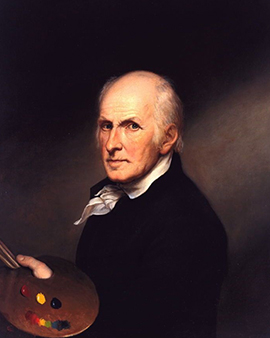Charles Willson Peale had actually always intended to practice a trade. In 18th century North America, for example, he tried his hand at making saddles and repairing watches. But neither of these was his thing. When he started painting, he still considered it a pure craft and wanted to make his third attempt. However, it soon turned out that Charles Willson Peale had a natural talent for portraits. It was more than just pure craft to draw famous people. He expressed his artistic sensibility. He first spent his early years as an apprentice at John Singleton-Copley. There he learned the basic techniques with which he would later give the people he would portray their most authentic and majestically dignified appearance.
The turbulent period of the 18th century American Revolution, which Charles Willson Peale followed with great interest, helped him to hold a series of meetings and sessions with famous commanders, politicians, and future presidents of the United States. But before he immortalized greats like Thomas Jefferson and Benjamin Franklin in paintings for future generations in the 1770s, he went to England to study under Benjamin West. Peale was very impressed by him, as he had taught himself to paint completely by himself. Through his creativity Benjamin West had become one of the first American painters to make a name for himself in England. West was of the opinion that portraiture was about allowing human beauty to be fully expressed in the painting. The way he was able to develop his raw talent in order to live up to this high standard led Peale to study under West.
Peal probably succeeded best in depicting the grace of true greatness with his portrait of George Washington, which is still famous today. In later years, after a fulfilling career as a portrait painter, he moved to Philadelphia, where he purchased a property. He christened it the Belfield Estate. There he dedicated himself to landscape painting at the end of his creative period. The house on it is now known as the Charles Willson Peale House and belongs to the National Historic Landmarks in the USA.
×





.jpg)
.jpg)
.jpg)
.jpg)
.jpg)
.jpg)
_1789_-_(MeisterDrucke-579031).jpg)
_1789_-_(MeisterDrucke-579031).jpg)
.jpg)
.jpg)
.jpg)
.jpg)
.jpg)
.jpg)
.jpg)
.jpg)
.jpg)
.jpg)
_c_1785_(watercolour_-_(MeisterDrucke-904356).jpg)
_c_1785_(watercolour_-_(MeisterDrucke-904356).jpg)
.jpg)
.jpg)
_Marquis_de_la_Rouerie_-_(MeisterDrucke-579267).jpg)
_Marquis_de_la_Rouerie_-_(MeisterDrucke-579267).jpg)
.jpg)
.jpg)
_-_(MeisterDrucke-379063).jpg)
_-_(MeisterDrucke-379063).jpg)
.jpg)
.jpg)
.jpg)
.jpg)
_1816_-_(MeisterDrucke-579403).jpg)
_1816_-_(MeisterDrucke-579403).jpg)
.jpg)
.jpg)
 1772 - (MeisterDrucke-44895).jpg)
 1772 - (MeisterDrucke-44895).jpg)
 after a drawing of the original by Charles Fraser (1782-1860) - (MeisterDrucke-149038).jpg)
 after a drawing of the original by Charles Fraser (1782-1860) - (MeisterDrucke-149038).jpg)
.jpg)
.jpg)
.jpg)
.jpg)
.jpg)
.jpg)
.jpg)
.jpg)
.jpg)
.jpg)
.jpg)
.jpg)
.jpg)
.jpg)
.jpg)
.jpg)
.jpg)
.jpg)
.jpg)
.jpg)
.jpg)
.jpg)
_after_the_Battle_of_Princeton_January_-_(MeisterDrucke-1021709).jpg)
_after_the_Battle_of_Princeton_January_-_(MeisterDrucke-1021709).jpg)
 c1790 - (MeisterDrucke-230324).jpg)
 c1790 - (MeisterDrucke-230324).jpg)
.jpg)
.jpg)
.jpg)
.jpg)
 1783-84 - (MeisterDrucke-264762).jpg)
 1783-84 - (MeisterDrucke-264762).jpg)
.jpg)
.jpg)
.jpg)
.jpg)
.jpg)
.jpg)
 - (MeisterDrucke-369812).jpg)
 - (MeisterDrucke-369812).jpg)
.jpg)
.jpg)
_-_(MeisterDrucke-1099584).jpg)
_-_(MeisterDrucke-1099584).jpg)
.jpg)
.jpg)
_-_(MeisterDrucke-579260).jpg)
_-_(MeisterDrucke-579260).jpg)
.jpg)
.jpg)
.jpg)
.jpg)
.jpg)
.jpg)
.jpg)
.jpg)
.jpg)
.jpg)
.jpg)
.jpg)
.jpg)
.jpg)
.jpg)
.jpg)
.jpg)
.jpg)
.jpg)
.jpg)
.jpg)
.jpg)
.jpg)
.jpg)
.jpg)
.jpg)
.jpg)
.jpg)
.jpg)
.jpg)
 - (MeisterDrucke-604983).jpg)
 - (MeisterDrucke-604983).jpg)
 - (MeisterDrucke-5961).jpg)
 - (MeisterDrucke-5961).jpg)
_-_(MeisterDrucke-1490288).jpg)
_-_(MeisterDrucke-1490288).jpg)
_-_(MeisterDrucke-1348278).jpg)
_-_(MeisterDrucke-1348278).jpg)
.jpg)
.jpg)
_and_John_Nicholson_Jr_-_(MeisterDrucke-1421436).jpg)
_and_John_Nicholson_Jr_-_(MeisterDrucke-1421436).jpg)
.jpg)
.jpg)
 - (MeisterDrucke-114292).jpg)
 - (MeisterDrucke-114292).jpg)
 engraved by George P - (MeisterDrucke-221313).jpg)
 engraved by George P - (MeisterDrucke-221313).jpg)
.jpg)
.jpg)
 - (MeisterDrucke-183257).jpg)
 - (MeisterDrucke-183257).jpg)
 - (MeisterDrucke-5957).jpg)
 - (MeisterDrucke-5957).jpg)
.jpg)
.jpg)
 engraved by James Barton Longacre - (MeisterDrucke-230138).jpg)
 engraved by James Barton Longacre - (MeisterDrucke-230138).jpg)
_-_(MeisterDrucke-1228391).jpg)
_-_(MeisterDrucke-1228391).jpg)
.jpg)
.jpg)
.jpg)
.jpg)
_-_(MeisterDrucke-1359029).jpg)
_-_(MeisterDrucke-1359029).jpg)
.jpg)
.jpg)
.jpg)
.jpg)
.jpg)
.jpg)
.jpg)
.jpg)
.jpg)
.jpg)
 - (MeisterDrucke-193024).jpg)
 - (MeisterDrucke-193024).jpg)
.jpg)
.jpg)
_-_(MeisterDrucke-878401).jpg)
_-_(MeisterDrucke-878401).jpg)
.jpg)
.jpg)
_and_John_Nicholson_Jr_-_(MeisterDrucke-1288723).jpg)
_and_John_Nicholson_Jr_-_(MeisterDrucke-1288723).jpg)
_-_(MeisterDrucke-1642098).jpg)
_-_(MeisterDrucke-1642098).jpg)
.jpg)
.jpg)
.jpg)
.jpg)
.jpg)
.jpg)
.jpg)
.jpg)
.jpg)
.jpg)
_-_(MeisterDrucke-1090226).jpg)
_-_(MeisterDrucke-1090226).jpg)
_c1795-1805_(oil_on_canvas)_-_(MeisterDrucke-1641147).jpg)
_c1795-1805_(oil_on_canvas)_-_(MeisterDrucke-1641147).jpg)
.jpg)
.jpg)
.jpg)
.jpg)
.jpg)
.jpg)
.jpg)
.jpg)
_-_(MeisterDrucke-1641455).jpg)
_-_(MeisterDrucke-1641455).jpg)






